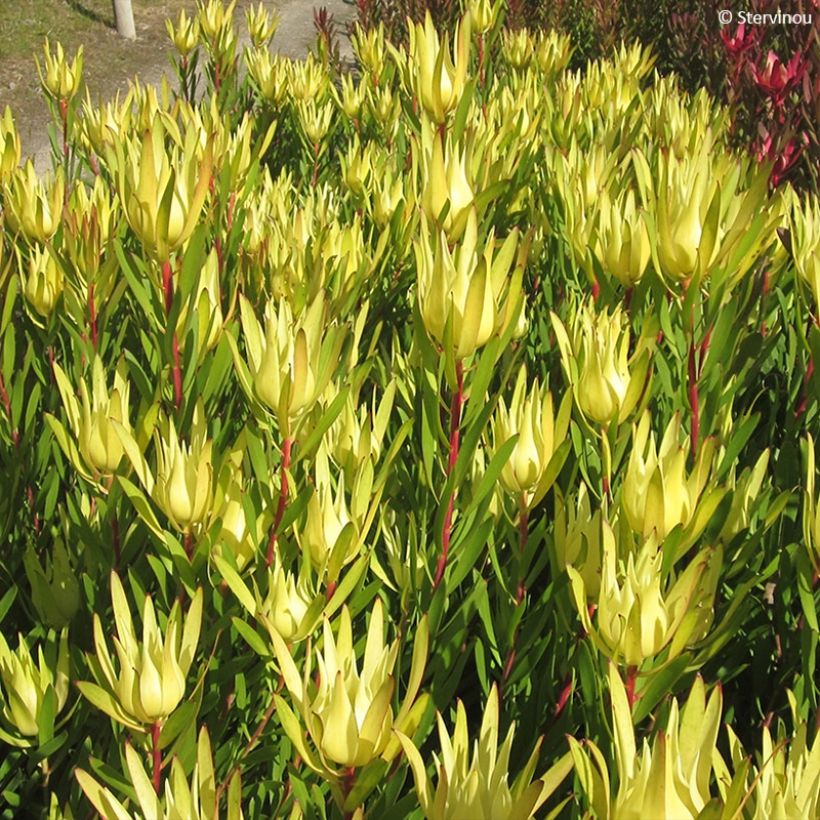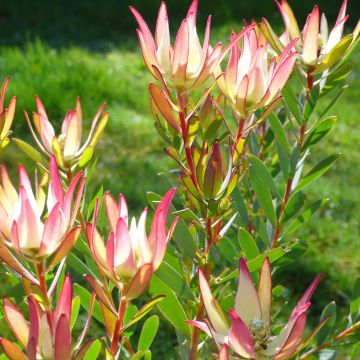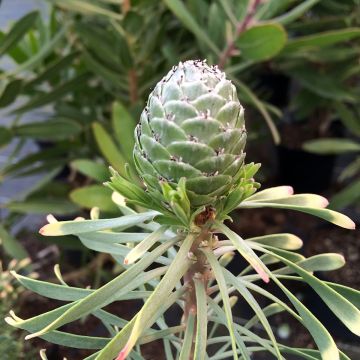

Leucadendron Inca Gold
Leucadendron Inca Gold - Conebush
Leucadendron laureolum x salignum Inca Gold
Conebush
This item cannot be shipped to the selected country
Delivery charge from €5.90
More information
Schedule delivery date,
and select date in basket
This plant carries a 24 months recovery warranty
More information
We guarantee the quality of our plants for a full growing cycle, and will replace at our expense any plant that fails to recover under normal climatic and planting conditions.
From €5.90 for pickup delivery and €6.90 for home delivery
Express home delivery from €8.90.
Does this plant fit my garden?
Set up your Plantfit profile →
Description
The Leucadendron 'Inca Gold' is part of a group of hybrid bushes between the Leucadendron laureolum and its close relative the L. salignum. Originally from South Africa, it is a frost-sensitive plant and somewhat delicate to grow, but very floriferous and strongly exotic in appearance. The bush adorns itself in spring with a multitude of unique inflorescences, resembling stars, composed of tough bracts of a vibrant yellow, surrounding a large heart composed of tiny golden yellow flowers. They bloom on a silky leaf, soft to the touch, in a tender green colour. Increasingly used in contemporary or Mediterranean-inspired compositions, especially by the sea, Leucadendrons are very graphic bushes that prefer large pots outside the mildest regions as it will be imperative to store them as soon as the first frosts arrive.
The Leucadendron 'Inca Gold' is a horticultural hybrid. It belongs to the proteaceae family and its ancestors are native to the Cape province of South Africa. Just like proteas, the Leucadendron are strange plants in every respect, they need fire to germinate their seeds. But, unlike proteas, male and female plants are distinct. 'Inca Gold' forms a dense, bushy, vigorous bush, quickly reaching 1.50 m in height and 1.30 m in span. Multiple stems emerge from a stump capable of regenerating after a fire. They bear ovate to elliptical evergreen leaves, pointed at their end, covered with silky hairs. They are light green in colour. Flowering usually occurs from March to May in our climates. The small, bright yellow flowers arranged in globular inflorescences are surrounded by numerous conspicuous bracts, organised in stars, whose colour changes over time from tender green to bright yellow.
The Leucadendron 'Inca Gold' is an unique and elegant plant of very mild climates and poor soils. It will be happy in coastal gardens spared from heavy frosts, in light, mineral, rather acidic soil. The gardens of the Corsican coast should be able to accommodate it in open ground. Particularly suited to the Mediterranean climate with long summers, it does not disdain the slightly cooler soils of the southern European Atlantic coast. It will look good isolated, on large slopes or in the background of exotic beds, but always in an open position, in full sun. In an exotic garden, it can be partnered with plants that appreciate the same growing conditions: the Canary Viperine, the Royal Protea, the Euphorbia characias, the Nolina hibernica, the paradise bird Strelitzia reginae, agaves, or palm trees with moderate growth such as the Blue Palm of Mexico (Brahea armata). In New Zealand, the flowers are highly appreciated in floristry, as they last a long time in bouquets while bringing a fantastic graphic and colour.
Report an error about the product description
Leucadendron Inca Gold - Conebush in pictures




Plant habit
Flowering
Foliage
Botanical data
Leucadendron
laureolum x salignum
Inca Gold
Proteaceae
Conebush
Cultivar or hybrid
Other Leucadendron
Planting and care
Plant the Leucadendron 'Inca Gold' preferably in the spring, or in the autumn in a very mild climate, in a very sunny and sheltered from the wind exposure. This plant requires a light, well-drained, filtering soil, low in nitrogen, with an acidic tendency. A mix of leaf compost, a little ericaceaous soil and river sand seems appropriate. The Leucadendron, like the proteas, are sensitive to excess phosphates and nitrates, so it is necessary to avoid giving too much fertiliser, or any at all. Adult plants tolerate occasional frosts of -5°C (23 °F) in dry soil, while young plants should be sheltered, in a frost-free location in a cool climate or under a winter veil in regions with mild winters. This plant flowers after about 4 to 5 years of cultivation from sowing. For indoor cultivation, it is important to ensure good room ventilation and to avoid watering with hard water.
Planting period
Intended location
Care
This item has not been reviewed yet - be the first to leave a review about it.
Evergreen shrubs
Haven't found what you were looking for?
Hardiness is the lowest winter temperature a plant can endure without suffering serious damage or even dying. However, hardiness is affected by location (a sheltered area, such as a patio), protection (winter cover) and soil type (hardiness is improved by well-drained soil).

Photo Sharing Terms & Conditions
In order to encourage gardeners to interact and share their experiences, Promesse de fleurs offers various media enabling content to be uploaded onto its Site - in particular via the ‘Photo sharing’ module.
The User agrees to refrain from:
- Posting any content that is illegal, prejudicial, insulting, racist, inciteful to hatred, revisionist, contrary to public decency, that infringes on privacy or on the privacy rights of third parties, in particular the publicity rights of persons and goods, intellectual property rights, or the right to privacy.
- Submitting content on behalf of a third party;
- Impersonate the identity of a third party and/or publish any personal information about a third party;
In general, the User undertakes to refrain from any unethical behaviour.
All Content (in particular text, comments, files, images, photos, videos, creative works, etc.), which may be subject to property or intellectual property rights, image or other private rights, shall remain the property of the User, subject to the limited rights granted by the terms of the licence granted by Promesse de fleurs as stated below. Users are at liberty to publish or not to publish such Content on the Site, notably via the ‘Photo Sharing’ facility, and accept that this Content shall be made public and freely accessible, notably on the Internet.
Users further acknowledge, undertake to have ,and guarantee that they hold all necessary rights and permissions to publish such material on the Site, in particular with regard to the legislation in force pertaining to any privacy, property, intellectual property, image, or contractual rights, or rights of any other nature. By publishing such Content on the Site, Users acknowledge accepting full liability as publishers of the Content within the meaning of the law, and grant Promesse de fleurs, free of charge, an inclusive, worldwide licence for the said Content for the entire duration of its publication, including all reproduction, representation, up/downloading, displaying, performing, transmission, and storage rights.
Users also grant permission for their name to be linked to the Content and accept that this link may not always be made available.
By engaging in posting material, Users consent to their Content becoming automatically accessible on the Internet, in particular on other sites and/or blogs and/or web pages of the Promesse de fleurs site, including in particular social pages and the Promesse de fleurs catalogue.
Users may secure the removal of entrusted content free of charge by issuing a simple request via our contact form.
The flowering period indicated on our website applies to countries and regions located in USDA zone 8 (France, the United Kingdom, Ireland, the Netherlands, etc.)
It will vary according to where you live:
- In zones 9 to 10 (Italy, Spain, Greece, etc.), flowering will occur about 2 to 4 weeks earlier.
- In zones 6 to 7 (Germany, Poland, Slovenia, and lower mountainous regions), flowering will be delayed by 2 to 3 weeks.
- In zone 5 (Central Europe, Scandinavia), blooming will be delayed by 3 to 5 weeks.
In temperate climates, pruning of spring-flowering shrubs (forsythia, spireas, etc.) should be done just after flowering.
Pruning of summer-flowering shrubs (Indian Lilac, Perovskia, etc.) can be done in winter or spring.
In cold regions as well as with frost-sensitive plants, avoid pruning too early when severe frosts may still occur.
The planting period indicated on our website applies to countries and regions located in USDA zone 8 (France, United Kingdom, Ireland, Netherlands).
It will vary according to where you live:
- In Mediterranean zones (Marseille, Madrid, Milan, etc.), autumn and winter are the best planting periods.
- In continental zones (Strasbourg, Munich, Vienna, etc.), delay planting by 2 to 3 weeks in spring and bring it forward by 2 to 4 weeks in autumn.
- In mountainous regions (the Alps, Pyrenees, Carpathians, etc.), it is best to plant in late spring (May-June) or late summer (August-September).
The harvesting period indicated on our website applies to countries and regions in USDA zone 8 (France, England, Ireland, the Netherlands).
In colder areas (Scandinavia, Poland, Austria...) fruit and vegetable harvests are likely to be delayed by 3-4 weeks.
In warmer areas (Italy, Spain, Greece, etc.), harvesting will probably take place earlier, depending on weather conditions.
The sowing periods indicated on our website apply to countries and regions within USDA Zone 8 (France, UK, Ireland, Netherlands).
In colder areas (Scandinavia, Poland, Austria...), delay any outdoor sowing by 3-4 weeks, or sow under glass.
In warmer climes (Italy, Spain, Greece, etc.), bring outdoor sowing forward by a few weeks.


















































